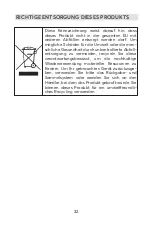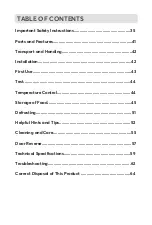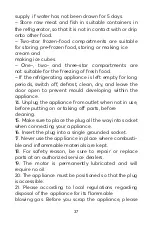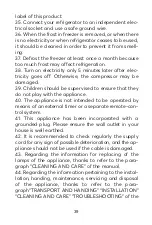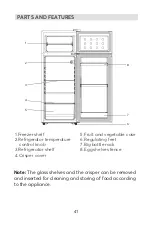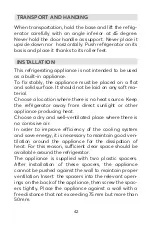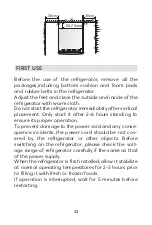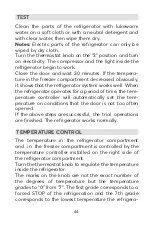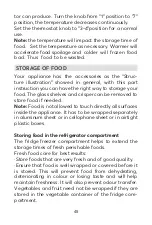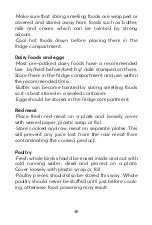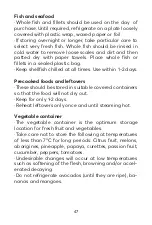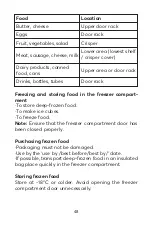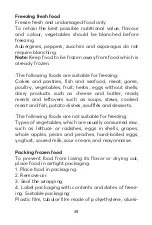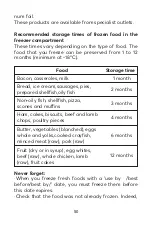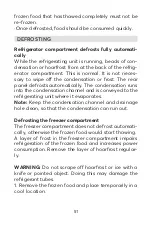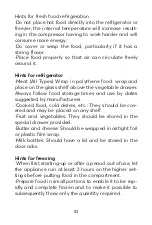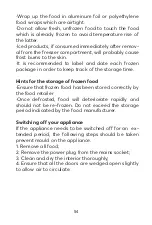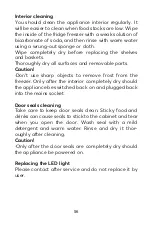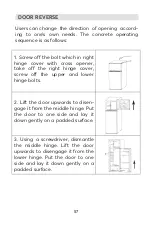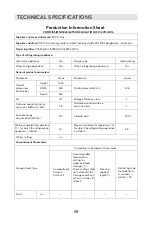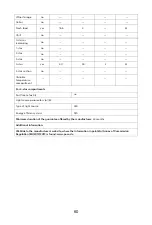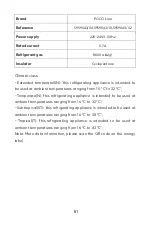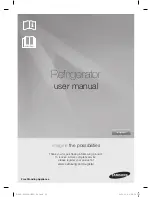
Your appliance has the accessories as the “Struc-
ture illustration” showed in general, with this part
instruction you can have the right way to storage your
food. The glass shelves and crisper can be removed to
store food if needed.
Note:
Food is not allowed to touch directly all surfaces
inside the appliance. It has to be wrapped separately
in aluminum sheet or in cellophane sheet or in airtight
plastic boxes.
Storing food in the refrigerator compartment
The fridge freezer compartment helps to extend the
storage times of fresh perishable foods.
Fresh food care for best results:
·Store foods that are very fresh and of good quality.
·Ensure that food is well wrapped or covered before it
is stored. This will prevent food from dehydrating,
deteriorating in colour or losing taste and will help
maintain freshness. It will also prevent odour transfer.
Vegetables and fruit need not be wrapped if they are
stored in the vegetable container of the fridge com-
partment.
·Make sure that strong smelling foods are wrapped or
covered and stored away from foods such as butter,
milk and cream which can be tainted by strong
odours.
·Cool hot foods down before placing them in the
fridge compartment.
Dairy foods and eggs
·Most pre-packed dairy foods have a recommended
'use by/best before/best by/ date stamped on them.
Store them in the fridge compartment and use within
the recommended time.
·Butter can become tainted by strong smelling foods
so it is best stored in a sealed container.
·Eggs should be stored in the fridge compartment.
Red meat
·Place fresh red meat on a plate and loosely cover
with waxed paper, plastic wrap or foil.
·Store cooked and raw meat on separate plates. This
will prevent any juice lost from the raw meat from
contaminating the cooked product.
Poultry
·Fresh whole birds should be rinsed inside and out with
cold running water, dried and placed on a plate.
Cover loosely with plastic wrap or foil.
·Poultry pieces should also be stored this way. Whole
poultry should never be stuffed until just before cook-
ing, otherwise food poisoning may result.
46
Fish and seafood
·Whole fish and fillets should be used on the day of
purchase. Until required, refrigerate on a plate loosely
covered with plastic wrap, waxed paper or foil.
·If storing overnight or longer, take particular care to
select very fresh fish. Whole fish should be rinsed in
cold water to remove loose scales and dirt and then
patted dry with paper towels. Place whole fish or
fillets in a sealed plastic bag.
·Keep shellfish chilled at all times. Use within 1-2 days.
Precooked foods and leftovers
·These should be stored in suitable covered containers
so that the food will not dry out.
·Keep for only 1-2 days.
·Reheat leftovers only once and until steaming hot.
Vegetable container
·The vegetable container is the optimum storage
location for fresh fruit and vegetables.
·Take care not to store the following at temperatures
of less than 7°C for long periods: Citrus fruit, melons,
aborigines, pineapple, papaya, curettes, passion fruit,
cucumber, peppers, tomatoes.
·Undesirable changes will occur at low temperatures
such as softening of the flesh, browning and/or accel-
erated decaying.
·Do not refrigerate avocados (until they are ripe), ba-
nanas and mangoes.
We recommend that you follow the tips below to
save energy.
·Try to avoid keeping the door open for long periods
in order to conserve energy.
·Ensure the appliance is away from any sources of
heat(Direct sunlight, electric oven or cooker etc)
·Don't set the temperature colder than necessary.
·Don't store warm food or evaporating liquid in the
appliance.
·Place the appliance in a well ventilated, humidity
free room.
Please refer to Installing your new appliance chapter.
·The “STRUCTURE ILLUSTRATION” shows the correct
combination for the drawers, crisper and shelves, do
not adjust the combination as this is designed to be
the most energy efficient configuration.
·Wrap up the food in aluminum foil or polyethylene
food wraps which are airtight.
·Do not allow fresh, unfrozen food to touch the food
which is already frozen to avoid temperature rise of
the latter.
·Iced products, if consumed immediately after remov-
al from the freezer compartment, will probably cause
frost burns to the skin.
·It is recommended to label and date each frozen
package in order to keep track of the storage time.
Hints for the storage of frozen food
·Ensure that frozen food has been stored correctly by
the food retailer
·Once defrosted, food will deteriorate rapidly and
should not be re-frozen. Do not exceed the storage
period indicated by the food manufacturer.
Switching off your appliance
If the appliance needs to be switched off for an ex-
tended period, the following steps should be taken
prevent mould on the appliance.
1. Remove all food;
2. Remove the power plug from the mains socket;
3. Clean and dry the interior thoroughly;
4. Ensure that all the doors are wedged open slightly
to allow air to circulate.
Hints for fresh food refrigeration
·Do not place hot food directly into the refrigerator or
freezer, the internal temperature will increase result-
ing in the compressor having to work harder and will
consume more energy.
·Do cover or wrap the food, particularly if it has a
strong flavor.
·Place food properly so that air can circulate freely
around it.
Hints for refrigerator
·Meat (All Types) Wrap in polythene food: wrap and
place on the glass shelf above the vegetable drawer.
Always follow food storage times and use by dates
suggested by manufacturers.
·Cooked food, cold dishes, etc.: They should be cov-
ered and may be placed on any shelf.
·Fruit and vegetables: They should be stored in the
special drawer provided.
·Butter and cheese: Should be wrapped in airtight foil
or plastic film wrap.
·Milk bottles: Should have a lid and be stored in the
door acks.
Hints for freezing
·When first starting-up or after a period out of use, let
the appliance run at least 2 hours on the higher set-
tings before putting food in the compartment.
·Prepare food in small portions to enable it to be rap-
idly and complete frozen and to make it possible to
subsequently thaw only the quantity required.
Interior cleaning
You should clean the appliance interior regularly. It
will be easier to clean when food stocks are low. Wipe
the inside of the fridge freezer with a weak solution of
bicarbonate of soda, and then rinse with warm water
using a wrung-out sponge or cloth.
Wipe completely dry before replacing the shelves
and baskets.
Thoroughly dry all surfaces and removable parts.
Caution!
·Don't use sharp objects to remove frost from the
freezer. Only after the interior completely dry should
the appliance be switched back on and plugged back
into the mains socket.
Door seals cleaning
Take care to keep door seals clean. Sticky food and
drinks can cause seals to stick to the cabinet and tear
when you open the door. Wash seal with a mild
detergent and warm water. Rinse and dry it thor-
oughly after cleaning.
Caution!
·Only after the door seals are completely dry should
the appliance be powered on.
Replacing the LED light
Please contact after service and do not replace it by
user.
For hygienic reasons the appliance (including exterior
and interior accessories) should be cleaned regularly
at least every two months.
WARNING:
The appliance must not be connected to
the mains during cleaning. Danger of electrical shock!
Before cleaning switch the appliance off and remove
the plug from the mains socket.
Exterior cleaning
·To maintain good appearance of your appliance,
you should clean it regularly.
·Wipe the digital panel and display panel with a
clean, soft cloth.
·Spray water onto the cleaning cloth instead of
spraying directly on the surface of the appliance. This
helps ensure an even distribution of moisture to the
surface.
·Clean the doors, handles and cabinet surfaces with a
mild detergent and then wiped dry with a soft cloth.
Caution!
·Don't use sharp objects as they are likely to scratch
the surface.
·Don't use Thinner, Car detergent, Clorox, ethereal oil,
abrasive cleansers or organic solvent such as Ben-
zene for cleaning. They may damage the surface of
the appliance and may cause fire.

